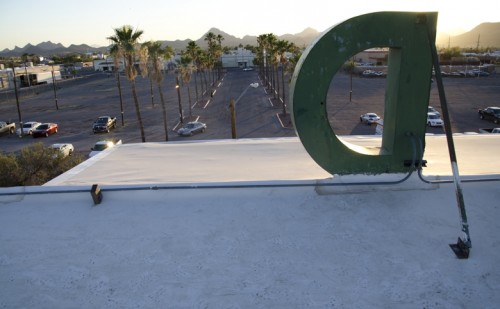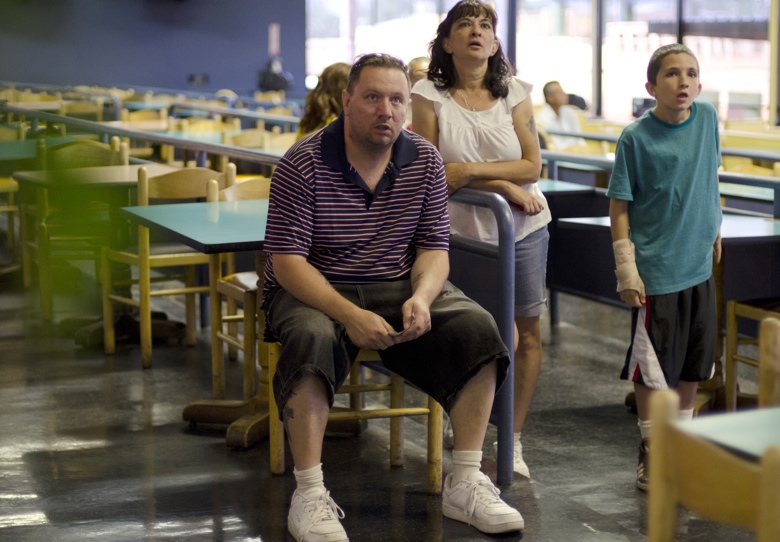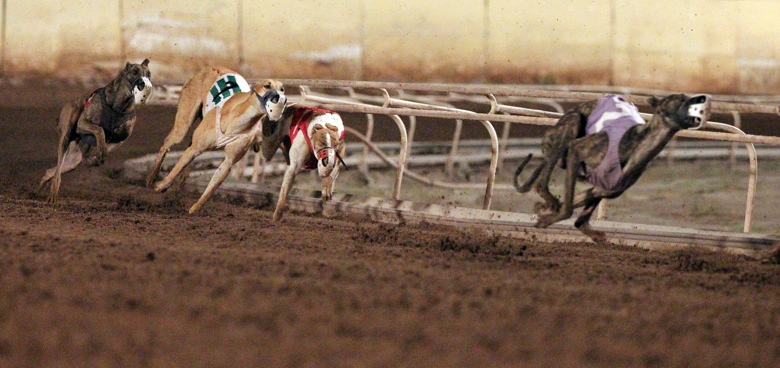Tim Walsh sat alone in the empty stands, a solitary spectator watching the sun set on Tucson Greyhound Park. Down below, a pack of dogs looped the lonely track, the first of a dozen races on a weeknight program.
Walsh would have been lucky to elbow his way out of the track’s parking lot in the 1970s, when thousands of people would jam into the stands, pressing against the rail fencing and shouting as the dogs they bet on dashed by.
Tuxedos and gowns were the norm, the smell of lobster would waft from the clubhouse and celebrity guests, like John Wayne, were the pulse of the party.

The empty parking lot at the Tucson Greyhound Park at sunset. The park is the last operational dog track in Arizona. Anibal Ortiz | NYT Institute
Tonight, the only voice echoing over the track is Walsh’s.
“Times are a-changin’,” said Walsh, who has gambled on dog racing for 30 years. “It makes me sad, but I’ve grown to accept that it’s just the way things are.”
Once a powerful industry, dog racing has become a shadow of its former self.
Since the 1980s, park attendance has shrunk from an average of 2,000 spectators to 30, said Alicia Heiserer, head of the track’s accounting department. That’s a 98.5 percent decrease.
Thousands of people used to attend nightly races at the Tucson Greyhound Park. Tonight, >30 #nytsji#panorama twitter.com/Taleb52/status…
— Amer Taleb (@Taleb52) May 23, 2013
Allegations of doping, protests by greyhound advocacy groups and competition from nearby casinos have pummeled the facility.
Nationwide, 27 tracks have shut down since 2001, and only 22 remain, Christine Dorchak, president of GREY2K USA, a greyhound rights group, said.
There used to be five operational dog tracks in the state. Tucson Greyhound Park is the last in Arizona. “There’s no interest in watching dogs run around in circles,” Dorchak said. “It’s a complete farce.”
Beyond the deserted clubhouse and up a flight of stairs is a rooftop booth. Inside is John C. Scott, the park’s announcer.
“From Tucson Greyhound Park, home of the fastest sport alive, it’s race Number 4!”

In his booth, John C. Scott, a track announcer, checks his sheet after announcing the dogs for a race at the Tucson Greyhound Park. Anibal Ortiz | NYT Institute
Scott’s signature voice rumbles through the abandoned bleachers.
In the 1970s Scott worked in a shed with neither air conditioning nor a decent view of the track.
Scott would stick his head out of a window to call the race, which became even more of an encumbrance when it rained.
The 70-year-old is witty, fast-talking and zings off one-liners that keep the booth rocking with laughter. Scott affixes one eye on the track, and sporadically swivels his chair around to the microphone in mid-sentence to make an announcement before turning back to finish a joke.
Greyhounds are strategic, he said. Some weave patiently through the pack, while others rely on sheer speed to zip past the finish line. It’s a sport that demands intellectual sophistication on the part of the gambler, he added.
“It’s not like a casino where you just pull a handle,” Scott said. “That doesn’t take any thought. It’s not even scientific for God’s sake.”

Kennel owner Mary Gray holds a copy of the Arizona Daily Star's August 11, 1978, Sports Extra section that featured her father. Like him, she is a kennel owner. Anibal Ortiz | NYT Institute
Very few people, he said, understand the local dog-racing scene more comprehensively than Mary Gray, a 56-year-old kennel owner.
She was in the park’s dining area on a Friday night lamenting the barren atmosphere.
“You could shoot a cannon through here and not hit anybody,” Gray said.
She sported a pink tank top, blue shorts and thinly rimmed glasses. Her body is inked with tattoos, including one of a greyhound.
Gray watched her first race at the park when she was 5 years old, and has been a kennel owner for nearly 20 years.
Her father was a nationally known kennel owner whose devotion to the sport was symbolized by the small notebook tucked into his hospital gown pocket as he lay on his deathbed.
He updated the book, his “Bible,” with details about greyhounds up until a few hours before he died.
Gray smiled as she reminisced about the park’s heyday, laughing and pointing in the air as though apparitions of the people she mentioned appeared before her. But like a tarnished photograph, her smile slowly withered as she began to speak about the industry’s decline, and possible extinction.
“The animal activists started kicking up about how we’re so cruel to these dogs, and I just want to slap them,” she said. “They’ve done so much damage because of their ignorance. They don’t understand that this breed lives for those 30 seconds out on that race track.”
The dogs line up with their handlers before every race. There are about 11 races per event. #nytsji twitter.com/Taleb52/status… — Amer Taleb (@Taleb52) May 23, 2013
Dorchak, of the greyhound rights group, rejected Gray’s assessment, saying nearly 1,000 dogs were injured in Arizona from 2007 to 2009. This included everything from broken backs to paralysis of the rear legs. According to a 2011 GREY2K USA report, 67 dogs were euthanized as a result of their injuries.
Gray’s dogs are locked in crates for 20 hours daily. She said that greyhounds are naturally comfortable in an enclosed area, while critics argue that the practice is barbaric. All 74 of her dogs have had at least “minor dings,” and three to five sustain career-ending injuries annually. She ceded that dogs can face serious harm, but said animal advocacy groups hype the risks out of proportion.
In addition, records from the Arizona Department of Racing highlight recent instances of drug-related problems among workers, including a track official who tested positive for a cocaine metabolite and a trainer who refused a drug test. Both were suspended.
Earlier this year, Pima County ordered the park to cease injecting female dogs with steroids intended to keep them from going into heat so that they could still race. The ban forced the park to reduce live racing from six days a week to four—a hit that has cost the track tens of thousands of dollars per week.

Betting stubs left on a table at Tucson Greyhound Park. The racetrack has faced a decline in attendance and popularity. Anibal Ortiz | NYT Institute
But with people placing bets via simulcast across the country, the track still averages $350,000 in weekly wagers, Heiserer, from the track’s accounting department, said.
Ivan Camarena, a chart writer, said he has never seen an instance of animal abuse.
Veterinarians, security guards and cameras are stationed throughout the track to monitor how animals are treated, Camarena said. The park also has an adoption program to find homes for retired greyhounds.
“The overwhelming majority of these animal rights people who hate dog racing and think it’s a deadly sport have never been here and don’t know what the hell they’re talking about,” Scott said. “These dogs are bred to run, born to run and that’s why they exist. They’re not pets until they stop running.”

Brian Hayes, 35, left, clutches his ticket, the last bet of the night, as Lisa Hayes, 47, and Brian's stepson, Anthony Woznick, 12, watch the race on the screen. Anibal Ortiz | NYT Institute
Brian Hayes, who attended a race with his fiancée and stepson, said he was frustrated with how critics portray the sport, especially if they have never been to a dog track.
“Are we bad people for betting?” Hayes asked. “We’re not villains. We’re enjoying a sport that’s been around for hundreds of years.”
Back in the dining area, Gray spoke about the pain of being pinned under the emotional rubble of her culture collapsing upon her. The traditions of her father, she said, may not be around much longer.
Dorchak said she recognizes that it is difficult to let go of old customs, but recommended that people base their view of dog racing on a single question.
“We should ask ourselves, what’s the best thing for these dogs that have suffered for so long?” Dorchak said. “Greyhounds love to run, but they don’t need to race.”
Scott, the announcer, admitted that the industry is dwindling, but said that the track’s owners are committed to seeking remedies for their monetary ailments. Gambling machines would be a shot in the arm for the park, but attempts to get the legislature’s approval have been unsuccessful.
“People who’ve lived here long enough have either come to this track or they know somebody who did,” Scott said. “No matter what happens, it’ll always be part of Tucson’s history.”
Rooftop view of a race at Tucson Greyhound Park.
Me on the race track’s roof vine.co/v/bV5Zh7v9Qlq — Amer Taleb (@Taleb52) May 25, 2013


 During the Institute, students are working journalists supervised by reporters and editors from The New York Times and The Boston Globe. Opportunities for students include reporting, copy editing, photography, Web production, print and Web design, and video journalism. Institute graduates now work at major news organizations, including The Associated Press, The Los Angeles Times, The Washington Post and The New York Times itself, and dozens of midsize news organizations.
During the Institute, students are working journalists supervised by reporters and editors from The New York Times and The Boston Globe. Opportunities for students include reporting, copy editing, photography, Web production, print and Web design, and video journalism. Institute graduates now work at major news organizations, including The Associated Press, The Los Angeles Times, The Washington Post and The New York Times itself, and dozens of midsize news organizations.
“Culture” and “tradition” does not equate with rightfulness. Let it go.
The people in the racing business need to face the music. This industry is in it’s final days, and should be ended sooner rather than later.
As more and more people are educated about the cruelties the greyhounds face, opposition continues to grow.
And on a financial basis, revenues are plummeting, nobody cares about watching greyhounds running on a track.
Please do the right thing and end this industry ASAP.
“In the 1970s Scott worked in a shed with neither air conditioning nor a decent view of the track.”
Hey what a coincidence, the greyhounds are stuffed into tiny cages and stay in a dark room with no air conditioning…
i know that traditions that are tied to money are hard to eliminate but the time is over for the hounds to run. change comes to all things. due to the exploitation of these dogs, this is no longer a “clean” entertainment for many, or most americans. i will not be sad to see it go the way of the all out dated traditions.
GREY2K USA reports facts based on well documented evidence. Trainers like Mary Gray don’t like to admit the truth because they fear the response from the public when the truth about the number of dogs injured and killed is presented. While they’re racing, as Mary Gray stated, greyhounds face the risk of serious injury and even death on the track. For too many greyhounds, the end of racing is the end of their life. The greyhound industry refuses to track what happens to greyhounds when they no longer race. Everything else about the dogs’ lives is recorded, but then that record keeping comes to an abrupt end. The industry often claims more than 90% of dogs are adopted after racing, but what happens to the rest? Some of those dogs are euthanized despite being healthy or having treatable injuries. Greyhounds are a commodity to the racing industry, and when one gets hurt or killed, they just bring in a replacement. We’ll never know just how many greyhounds are killed.
As Mary Gray also acknowledged, these greyhounds are locked in small cages for 20 and more hours per day. Some of the kennels at Tucson Greyhound Park have been cited for the deplorable conditions in the buildings. The industry contradicts themselves by saying “greyhounds love to run” but in the same breath, “greyhounds love to lounge in their cages.” So which is it? Every greyhound I’ve ever known has enjoyed the occasional run, but they’ve also enjoyed “lounging” on comfortable dog beds (or couches) and lying in the sun on a warm day. If you were to keep a companion animal locked in a cage for 20 hours per day, you’d be viewed as inhumane. The industry doesn’t see greyhounds as companion animals though, they see them as commodities, so they have no problem with this confinement.
I am very glad to see the industry continuing to decline. The end of greyhound racing will be a great day for the greyhounds. It can’t come soon enough.
For more details on the industry and the greyhounds, please visit http://www.grey2kusa.org.
Thanks for the informative article. It’s somewhat heartening to hear that greyhound racing is crumbling. However, I want it to implode. I wish the reporter would’ve addressed TGP’s lack of transparency and accountability and the lack of injury reporting.
I want to add that the reporter just took TGP’s word that they have an adoption program. Say what? If you look at the website for the track – tucsongreyhound.com – their link to learn more about the adoption program goes to a Facebook page that hasn’t been updated since Feb. 2012. That adoption program is long gone; kicked to the curb. Also the adoption group that was listed in the article as a resource only has 4 available greyhounds on it. Arizona Adopt a Greyhound was once the largest adoption group but that was when Phoenix Greyhound Park was still open (now mercifully closed and demolished). AAGI should update their website content to adjust to their new status.
These other AZ adoption groups should also be posted as resources:
GPA – Greyhound Pets Arizona
Southern Arizona Greyhound Adoption
Arizona Greyhound Rescue
Arizona Greyhounds Inc.
I am very pleased to read that greyhound racing is fast on its way out in the US and in Britain too. I hear constantly of trainers/owners love of this breed and yet those people are happy to put the dogs onto dangerous tracks. The first bend is the cause of most of the injuries. Fast straights leading into tight bends are lethal. Once the dogs have too many niggling injuries they are dispensed with, shot, poisoned and if they are very lucky, found safe and loving homes.
The use of animals for our entertainment really needs to end and with the internet, where people can see the truth of this vile industry, wild animals being used in circuses, factory farming, wearing fur etc. It is time the human race became humane, respected fellow creatures.
A very well written, well balanced article. Too bad you can’t do a series on the track as there were statements made by some of the people you interviewed that, if followed up, could be stories of their own. For example, the comment by Mr. Hayes that greyhound racing has been around for “hundreds of years.” If fact, the mechanical lure was invented in the 20’s which, at best would make racing less than 100 years old. Also, Mr. Scott mentioned the damage casino style gambling has done to racing, but Ms. Gray seemed to blame “animal rights activists.” I’m sure both have contributed, but it would be interesting to find out which has been a greater cause of the industry’s decline.
Really! 20 hours a day in a small cage, I would be glad to be running for that few minutes too! How cruel! If that were a child, it would be considered abuse for sure.
I am the very proud parent of three greyhounds currently in my home. I’ve rescued 6 in total. Greyhounds are a sweet loving dog with a kind, gentle nature. The statement that sums up the situation the best is from Christine Dorchak with GREY2K USA
“We should ask ourselves, what’s the best thing for these dogs that have suffered for so long?” Dorchak said. “Greyhounds love to run, but they don’t need to race.”
The last at the end of the article says it best. “greyhounds love to run, but they don’t need to race”.
Do your homework, Mr. Barton. Racing (coursing) have, in fact, been around for hundreds of years. And will likely continue for hundreds more.
“We should ask ourselves, what’s the best thing for these dogs that have suffered for so long?” Dorchak said. “Greyhounds love to run, but they don’t need to race.” I wonder how she knows that. I see pups in long runs that race each other all the time at a greyhound farm and no one and I mean no one is making them do it and they haven’t been trained yet so I think saying that they don’t want to race is a lie. Maybe they are not fast enough for a race track but I think they all love to race.
What will happen if they close all the tracks there will still be a few die hard greyhound folks that will still race their dogs against each other with money being bet on the side and not paying any taxes on what is won. No rules or state veterinaries to go over the dogs to see they are healthy. No more pet greyhounds they will go the way it was years ago. If they don’t win they will be killed or given away to some hunter, just turned loose or put in a animal shelter where they have a way less chance of being adopted as a pet than being sold to some research group or put down. They won’t be DNA to check against and tattoos so no one will have any way to know who one belongs to so no way to bring charges against anyone doing anything wrong like the guy that was at Ebro that is now in jail.. No inspection people to go to farms and race tracks to monitor the care the dogs get or to make sure all the vaccination records are up to date or even given. If you really care for greyhounds and their care the last thing you would or should want done is greyhound racing stopped at the race tracks. – Bart Fuller
Throughout the world greyhound advocates say the same thing: mass culling, over-breeding, traumatic injuries – broken bones, torn gracilis muscles, paralysis, smashing into stationary objects, dislocations, torn pectoral muscles, torn hip supports – yet the industry, unbelievably, keeps minimizing all this as nothing. What this reveals is the human mind in motion – our enormous capacity to deny, rationalise, compartmentalise and justify things that are not palatable, because we have another motive – in this case, to gamble, and stop ourselves feeling what we’d feel if we stop gambling. Those involved in all areas of animals-as-entertainment – rodeo, circus, horse/dog/pigeon racing, marineland type facilities for ocean creatures say the same kinds of things, trying to make it ok to imprison orcas, torment and terrify cattle, calves and horses, train dogs, horses and pigeons to race to what may be their deaths. You just have to look at what the animals experience, and ask yourself, would YOU want to be somersaulting head over heels like that? Would YOU want the muscle of your buttocks torn from your pelvic bones? Would YOU be happy to smash into a stationary object (rail) at 60kph without even a vehicle and seatbelt to protect you? Would YOU want to fly such enormous distances you died on the way? Would YOU like to be washing-lined by a rope, or forced to live for 30 years in a small tank? If the answer is no, then why do you accept this happening to animals? Animals are sentient – research shows they feel physically and emotionally, have complex minds, remember, mourn, are intelligent, have complex social lives, are capable of solving puzzles and learning. Cruelty-entertainment is not on. Think about it. If you have to gamble and choose not to get help to address this, then please, choose something else to gamble with – not the lives of the creatures with whom we inhabit the planet.
I have been the proud care-taker of 5 retired racing Greyhounds. My current two were rescued when they suffered a broken leg in a race. Groups had 24 hr notice to rescue or they would be euthanized — no longer monetarily viable for the owners. Mary Gray shows her ignorance of the breed when she says they were bred to run, born to run, and why they exist. Greyhounds are one of the oldest breeds — originally bred for hunting and treated as and a symbol of nobility — dog racing has taken that away. All of my Greyhounds do not love to run any more than any other breed. They are sweet, docile, lazy hounds that love to sleep peacefully in a home where they are loved and taken care of and they do not “live for those 30 seconds” of running on a track. It’s all about money — the dogs are being used for monetary gain – that’s it plain and simple. If they start costing the owners money — they are gone, one way or another and they don’t care. Please don’t support this industry by attending dog races. And, for those of you who would tell me that doing away with racing will mean I don’t have Greyhounds as pets anymore — I would gladly forgo ever having another in exchange for knowing not a single one would endure this torture again.